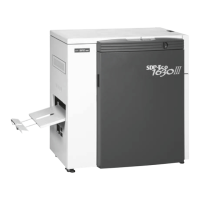
Do you have a question about the Mitsubishi SILVER DIGIPLATER SDP-ECO 1630 III and is the answer not in the manual?
| Print Technology | Laser |
|---|---|
| Print Speed (Monochrome) | 16 ppm |
| Print Resolution | 600 x 600 dpi |
| Paper Capacity | 250 sheets |
| Scanner Type | Flatbed |
| Scanner Resolution | 600 x 600 dpi |
| Copy Speed | 16 cpm |
| Copy Resolution | 600 x 600 dpi |
| Fax Modem Speed | 33.6 Kbps |
| Connectivity | USB |
| Operating System Compatibility | Windows |
Read and understand manual, follow warnings, keep manual accessible for safe operation.
Covers CISPR, FCC, Canadian regulations, export rules, and liability limits.
Outlines the content of chapters covering safety, operation, and maintenance.
Explains the meaning of WARNINGS, CAUTIONS, and Notes for user guidance.
Covers machine usage, grounding, electrical, laser, chemical safety, and warnings.
Precautions for operation, transport, installation, maintenance, and disposal.
Identifies major parts of the main unit, including covers, switches, and sockets.
Details the operation panel layout, buttons, lamps, and the function of safety switches.
Step-by-step guide on how to load and set a plate roll onto the spool shaft.
Procedures for handling the end of a plate roll during exposure or when it needs removal.
Checks cables, power on, initialization, and plate data input.
Details exposure modes, processor operation, chemical handling, and shutdown.
Introduces the user menu for checking status, errors, and settings.
Details how to use keys, select menus, switch modes, and execute commands.
Setting plate data, laser resolution, and performing test exposures.
Covers pre-feed, image data, modes, maintenance functions, and rinse settings.
Procedures for cleaning cutter blades, lenses, filters, and processor sections.
Cleaning tanks, rollers, replacing sheets, and managing expendable parts.
Classifies messages into status, warning, and error types for system monitoring.
Explains how to display and interpret warning messages and status indicators.
Comprehensive list of error codes and procedures for removing plate jams.
Lists key technical details of the machine, including dimensions, performance, and power.
Provides dimensional drawings and an overview of the machine's physical layout.